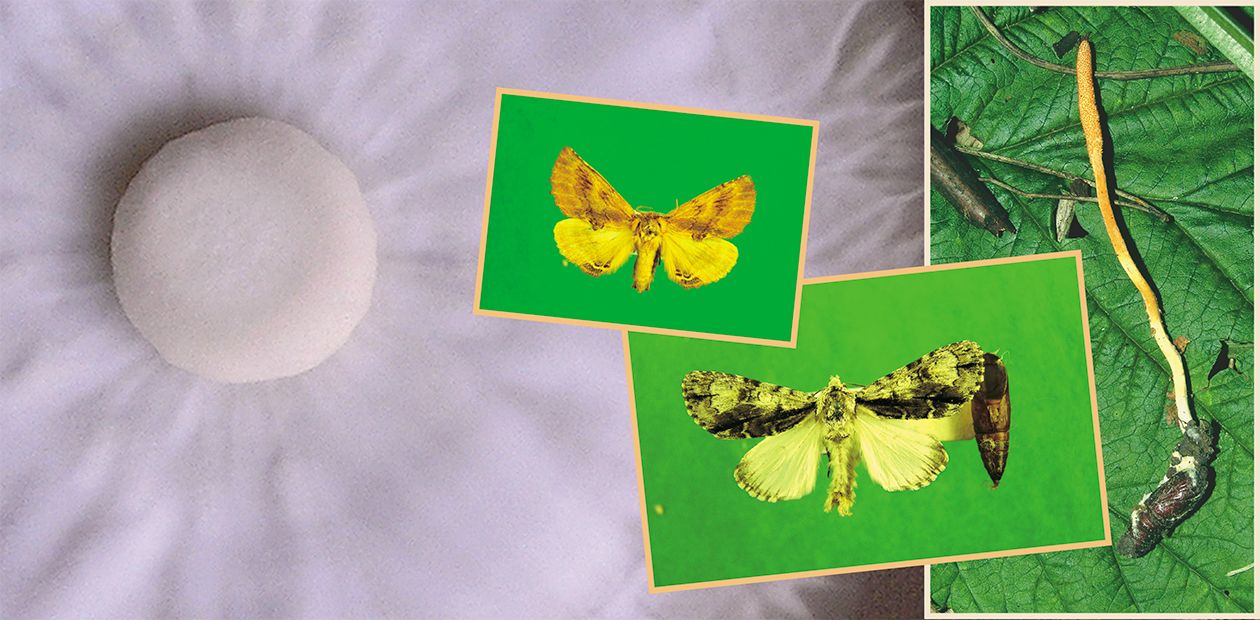Medicinal "Herb That Eats Caterpillars"
The world of fungi is amazingly rich and diverse: they are justly united into a separate kingdom, along with the kingdoms of animals and plants. However, our knowledge about these creatures is mainly confined to cooking and medical applications.
Fungi can parasitize not only mammals: two thousand fungal species live at the expense of various invertebrates, including about one thousand of entomopathogenic species, i. e., the species affecting insects. In addition, several species of such fungi synthesize biologically active substances, which can be successfully used in pharmacology for designing efficient drugs
Parasitic fungi are among important natural regulators of insect population in terrestrial and aquatic habitats. Some fungal species are readily cultivable under laboratory conditions; consequently, they are frequently used for production of biopreparations safe for humans and environment, for controlling mass insects, such as Colorado potato beetle, locusts, aphids, and others. However, our interest in these unique creatures of nature is determined by one more fact: some fungal species have been used for ages in the traditional oriental medicine.
“The Herb of Life”
The ascomycetes belonging to the genus Cordyceps are interesting from the standpoint of medicine. For example, use of the fungus C. sinensis, growing on caterpillars of ghost moths in the mountain regions of China, Tibet, and Nepal, as a medicine was reported in 1082. Tibetans call this fungus Yarsa-Khumbu, which means “summer herb — winter insect”; Chinese, Dong chong xia cao, i. e., “the herb that eats caterpillars”; and Nepalese call it Jivan booti — “the herb of life”.
Indeed, the fruiting bodies of C. sinensis contain unique substances — the polysaccharides that display immunomodulatory, antibacterial, and antiviral properties. This fungus is considered the most valuable remedy for asthma, hepatitis, vascular and renal diseases, liver cirrhosis, cancer, and many other serious diseases. A number of researchers have demonstrated that other fungal species belonging to the genus Cordyceps display analogous pharmaceutical properties.
Members of the genus Cordyceps inhabit mainly the subtropical and tropical regions; however, many species have been also found in temperate latitudes. Cordyceps militaris, inhabiting Eurasia, North America, and North Africa, is considered the most common species of this genus. This species is frequently met on the territory of Russia, mainly in the Primorsky krai and, more rarely, in the central and southern parts of European Russia. Data on the C. militaris abundance and biology in Siberia were virtually absent until recently, except for the two instances when this fungus was found in the Irkutsk and Novosibirsk oblasts in the 1990s.
Originating from West Siberia
Scientists from the Laboratory of Insect Pathologies with the Institute of Systematics and Ecology of Animals, Siberian Branch of the Russian Academy of Sciences, conducted a long-term (1999—2006) parasitological research in the southern part of West Siberia as well as in Northeastern and Central Altai. Thus, they first discovered the filamentous fungi, the fungal species unable to form fruiting bodies and belonging to the genera Beauveria and Paecilomices, which affect insects belonging to various orders, mainly, beetles, bugs, and moths.
By the end of summer-fall season of 2007, the fruiting bodies of C. militaris were found in birch-pine forests in the neighborhood of Bolotnoe, a town in the Novosibirsk oblast, on an area of several hectares. In the forests examined, the hosts of this fungus were various lepidopterous species, namely, notodontid, noctid, geometrid, and thyatrid moths; moreover, virtually all the individual pupae found were infested.
The caterpillars of these moths live from July to September on birches, aspens, willows, bird cherry trees, and other trees and bushes, and their pupae winter in the forest litter and soil. The maximum density of the pupae and, correspondingly, fungal fruiting bodies on the site studied was impressive — 20 specimens per each square meter! This high population was recorded at the interface of the forest and fellings in the brushwood overgrown with raspberry bushes and nettle as well as near the tree butts covered with moss and old stumps.
The fungus C. militaris is especially variable in the size of fruiting bodies as well as in their number, shape, color, and other traits. So far mycologists have described a number of very similar members of this genus; this suggests that the fungi belonging to a complex of closely related species are discovered in the Novosibirsk region. This assumption as well as a detailed study of the life cycle and ecological preferences of these “Siberians” undoubtedly requires further and more comprehensive field and laboratory studies.
By now several C. militaris isolates were recovered into culture as an asexual stage, i.e., fungal mycelium, from the fruiting bodies collected in nature. One of the research tasks now is to select the artificial nutrient media where the fungus will develop the fruiting bodies, which possess the healing properties. A new less expensive raw stuff for medical purposes could be obtained after a comprehensive study of the C. militaris biochemical and pharmacological properties.
Candidate of Biology V. Yu. Kryukov and O. N. Yaroslavtseva (Institute of Systematics and Ecology of Animals, Siberian Branch of the Russian Academy of Sciences, Novosibirsk, Russia)








